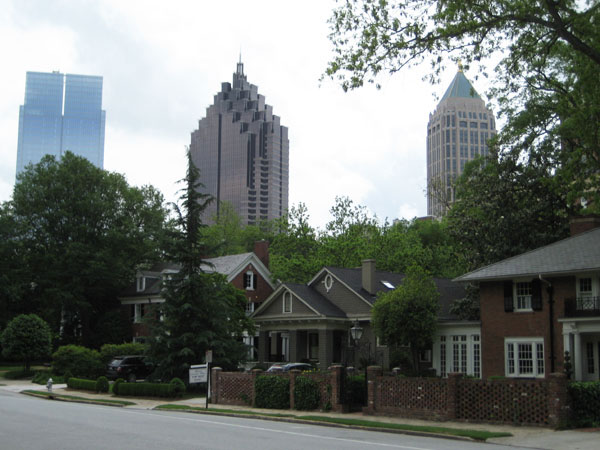Ansley Park: Atlanta, Georgia

Summary
Large expanses of lush green parks are the hallmark of this 107-year-old garden suburb, which reflects design principles espoused by Frederick Law Olmsted. The brainchild of attorney and real estate developer Edwin P. Ansley, the 275-acre neighborhood was designed so that no home is more than a 10-minute walk from one of 14 parks, five of which create a continuous link from northeast to southwest. Curvilinear streets with landscaped promenades are flanked by sidewalks, and the neighborhood offers striking skyline views of Atlanta's vibrant Midtown Business District.
Designated Area
Boundaries are the Beverly Road and Spring-Buford Connector to the north, Piedmont Avenue and the railroad to east, Peachtree Circle NE to the west, and 15th Street NE and Lafayette Drive to the south.

Striking skyline views of Atlanta's Midtown Business District are afforded by various points in the neighborhood, including Peachtree Circle. Photo Atlanta Urban Design Commission.
Planning Excellence
Originally designed for the horse and carriage, today the wide streets are used by motorists as cut-thrus. A 2011 streetscape program will improve pedestrian safety, add tree cover, and facilitate traffic flow.
Ansley Park has only one non-residential building — a church — within its borders, but the neighborhood is only a short walk from numerous institutions, districts, and amenities. MARTA bus and rail serve the neighborhood, and an AMTRAK station is nearby. When the Atlanta Beltline is complete, light rail and a 33-mile multi-use trail system will be accessible along part of the neighborhood's eastern edge.
A National Register Historic District, Ansley Park features an eclectic mix of architecture. Apartments, condominiums, and townhouses have made the neighborhood's density one of the highest in Atlanta. Public housing, initially resisted, has been welcomed in this higher-income, history-rich community.
Suburbia's rise fueled Ansley Park's decline after World War II. In the 1960s, young families seeking large, inexpensive homes were drawn to the area, though obtaining mortgage and repair loans was hard. A local bank, concerned about its mortgage portfolio, offered to partially fund a neighborhood restoration plan. That 1964 plan, which spurred revitalization, continues to shape Ansley Park.
After the 1964 Civil Rights Act made it illegal to deny anyone the right to rent, buy, or sell housing on the basis of race, color, religion, or national origin, some Atlanta residents abandoned the city. Residents of Ansley Park adopted a statement welcoming all to their neighborhood.

Ansley Park features a mix of housing types, setbacks, and architectural styles, including Baroque, Craftsman, Tudor, Queen Anne, Italianate, Prairie School, and this example of Modern architecture. Photo Atlanta Urban Design Commission.
Defining Characteristics, Features
Sustainability
- Primarily residential, neighborhood within easy walk to shopping, arts districts
- MARTA bus and rail serve Ansley Park at perimeter; Amtrak station nearby. Atlanta Beltline will connect residents to light rail and pedestrian and bicycle trails
- Extensive park system provides shade, reduces urban heat-island effect
- Beautification Foundation monitors water bodies, ensuring health of creeks, streams
- New streetscape project reduces impervious surface areas and stormwater runoff
Role of planning
- Original plan (1904) crafted by landscape designer Solon Z. Ruff based on principles employed in the Frederick Law Olmsted, Sr., plan for New York City's Central Park
- Ansley Park Civic Association (APCA) hires Eric Hill Associates and Leon Eplan, AICP, to draft neighborhood plan (1964), which seeks to preserve and defend community character
- Throughout 1960s residents attend public hearings, waving copies of APCA plan, urging rejection of proposals undermining their vision; influence of 1964 APCA plan continues today
- APCA secures $3.3 million from government agencies for plan and implementation (2008-2011) of traffic calming initiatives. Improvements seeks to reduce vehicle speeds and required stops, increase safety, discourage cut-through traffic, improve pedestrian connectivity
Urban forest
- Fourteen-park linear greenway system makes up 30 percent of Ansley Park's footprint; many homes have gracious front yards, wooded backyards
- Parks are adorned with old-growth trees, hearty plants, colorful flowers; stone benches serve as contemplative stopping points; large stepping stones lead to unique creek bridges; tennis courts, children's playgrounds, baseball diamonds, and gazebo found in various parks
- Piedmont Park — 189 acres that is home to Atlanta Botanical Gardens, aquatic center, and dog park — sits on neighborhood's southeastern border; undergoing 53-acre expansion
- Private, 45-acre Ansley Golf Club is northeastern boundary; nine-hole course known for graceful curves and dips, and skyline views of Midtown Business District

Wide, curvilinear streets meander along gently rolling hills. A 2011 streetscape program includes traffic calming initiatives to combat cut-through traffic and improve pedestrian connectivity, among other measures. Photo Atlanta Urban Design Commission.
Neighborhood aesthetics
- Curvilinear streets meander along gently rolling hills
- Mix of housing (grand to modest), setbacks and type (garage apartments, apartment and condo buildings, townhouses) add visual and economic diversity to neighborhood
- Added to National Register of Historic Places (1979); diverse architecture including Modern, Baroque, Craftsman, Tudor, Queen Anne, Italianate, Prairie School
- Granite found throughout neighborhood; original granite blocks, used for mounting horses, are situated along curbs. Ansley Park Beautification Foundation (1982) utilizes the igneous rock to create permanent markers at all entry ways; granite entrance is being crafted for Eubanks Park
Engaged citizens
- Formed as social club (1915), during 1950s Ansley Park Civic Association becomes an activist organization to improve neighborhood integrity, sense of community; APCA supports planning initiatives, administers weekly security patrols; plans annual tour of homes, July 4th parade, community yard sale
- Bucking prevailing attitudes, 15 Ansley Park residents craft statement (1968) welcoming all to reside there, regardless of race or color. Most residents sign and APCA board endorses
- Despite initial reservations, Ansley Park welcomes public housing (1974); neighborhood is model for successful integration of lower-income housing into affluent area
- Beautification Foundation is steward of parks, islands, and water features; has improved 95 percent of unusable space, clearing overgrowth, planting flowers, placing furnishings. Island sprinklers and playground equipment among successful fundraising ventures


